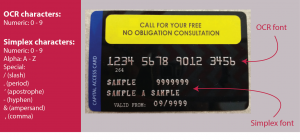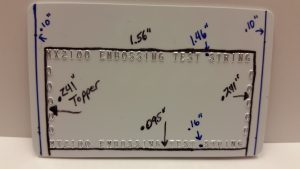Can CPS Cards help you with embossed cards for your direct mail campaign? Contact us or call 888.817.8121 to talk to one of our card experts.
Embossed Cards: Tips for Your Next Direct Mail Campaign
So you want to use an embossed card to help improve lift in your next direct mail campaign? Great! Embossed cards provide a perceived value that gets your recipients to open the envelope. But before you begin to work on your card design, here are a few things to consider before diving in.
FONTS
Embossing is a 50+ year old technology and although it has evolved over the years, there are still some limitations when it comes to “the look” of embossing. Most embossers limit the font type to OCR only (the same font used on bank credit cards). Here at CPS, we use both OCR and Simplex fonts. The OCR font is used for numeric characters only, while the Simplex font is used for both alpha and numeric characters, as well as special characters. You can use either one or both fonts in your card design. Other printing techniques, like Inkjet and thermal printing, provide more font options, but don’t carry the same perceived value that comes with an embossed card.
ARTWORK
When it comes to designing the artwork for your card, there are a few things to keep in mind. First, you will want to make sure that the embossed characters do not interfere with the background design, so allow for the max number of characters (19 per line for OCR, 28 per line for Simplex) when designing artwork. For example, if a customer’s name is very long, it may run into a phone number or logo imaged on the card. Secondly, you’ll want to stay away from using borders in the artwork. Since plastic cards can shift slightly during die-cutting, a border used in the artwork can make the card look off center.
TIPPING
Tipping refers to the application of color ink to the raised characters created by the embosser. Cards can be tipped in a number of colors, but you are probably most familiar with seeing silver tipping, which is often used on bank credit cards. But there are many other colors to choose from as well, including black, white, gold, and more. Your card vendor can help you select the best color for your card’s artwork, as some tipping colors might be difficult to see against a similarly colored background. For example, silver tipping may not be the best choice against a gray background.
CARD THICKNESS
Embossing is limited to certain card thicknesses. Typically, cards with a thickness of 20 mil to 30 mil (traditional credit card thickness) work best for embossing. The thicker, the better, actually. While you might save money with a thinner card, you will not get the same lift rates on your direct mail if your recipient cannot feel the card inside. The perceived value lies in the thickness of the card, therefore, a 24 mil or 30 mil card is always recommended.
EMBOSSING “ZONE”
Not all embossing machines are created equal. Depending upon the manufacturer, the embossing zone on the card will vary depending upon the machine that is being used to emboss. Your card vendor can provide a card template that indicates their embossing parameters. Be prepared to avoid the perimeter of the card, as this is usually off-limits to embossing.
CHARACTER SPACING
When designing your card, you should consider how many characters will be needed for your customer’s name, account number, or other personalized information. Sometimes you may find that you accounted for enough space for someone named Josephina Esperaldo, whenever you should have considered someone with a longer name, like Rebecca Convington-Winn. When in doubt, turn to your card provider for help. Typically they will provide you with guidelines for the maximum number of characters allowed per line and will provide proofs to help you visualize how the finished product will look.
CORRECT DATA
The most important part of the embossing process is the data. If your data is not correct, your cards will not be either. Work with your card supplier to ensure that your data is formatted as required. A missing field or code or a line that requires numeric characters only, but includes alpha characters as well, could result in errors and delays in production. Most card vendors will be able to catch these errors in the proofing process, but a proactive step in understanding what is required is always the best bet. A reputable card vendor will have a tech team to help work through any data issues that may occur.
CARD AND CARRIER MATCHING
Traditionally, either the OCR line is a sequential number, or the card has a 4 – 6 digit sequential number appended to it. It’s critical the mail shop work with the card vendor to insure the numbers are the same on the matching letters. In addition, take extra precaution and do some testing ahead of time to be sure the cards are packaged in their sleeves and on the skids to match the sequence the letters are run in. If it absolutely necessary for the card to match the letter, ask your card vendor if they can provide a computer matched product where the letter is addressed, the card is embossed and matched to the letter, and the letter is folded, all in one computer controlled pass.
RED FLAGS
Before you begin your project, there are a few more things to consider. If your card requires an activation label, consider its placement when designing your artwork. Labels are typically applied above, below or beside the embossed characters. Sometimes they are applied prior to the embossing process, so it is vital that you provide enough clearance for the embossed characters. If you would like a signature panel on the back of the card, it should steer clear of the embossing area on the front of the card as it would be difficult to sign an area that is debossed. And finally, if you have considered trying to save a little money by using a paper card, think again. Paper cards do not fare well with embossing as the raised characters crack the paper.
Although embossing is a very simple form of personalization, there are still many rules when it comes to using this printing medium. Choose a card vendor that is knowledgeable and can help you navigate all of your embossing options.

